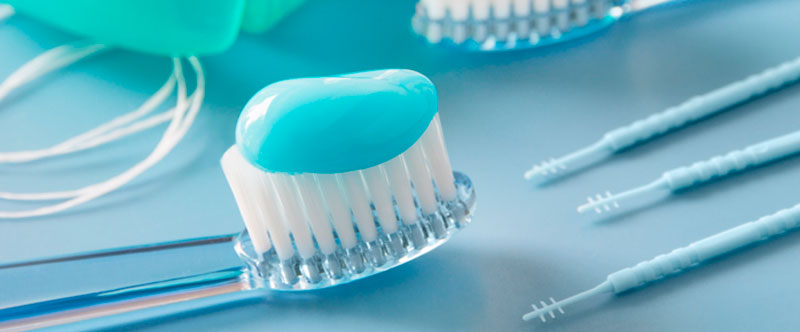
Once you have your orthodontic appliances or braces in place, keeping you teeth, gums and appliances clean is very important.
Braces, wires, bands and retainers can all trap food particles and make it difficult to brush or floss away plaque. Careful brushing and flossing, preferrably after every meal and snack, is the best way to prevent plaque build up, tooth decay, and gum disease.
Use a toothbrush with soft bristles and a small strip of fluoride toothpaste, unless the child is under the age of 3. If a child is younger than age 3, parents should clean their child’s teeth with water and a soft-bristled toothbrush. After age 3, parents should supervise brushing. Use no more than a peasized amount of toothpaste and make sure children do not swallow excess toothpaste.
When you brush your teeth, move the brush in small circular motions to reach food particles that may be under your gum line. Hold the toothbrush at an angle and brush slowly and carefully, covering all areas between teeth and the surface of each tooth. It will take you several minutes to thoroughly brush your teeth. Brush up on the lower teeth, down on the upper teeth and the outside, inside and chewing surface of all of your front and back teeth. Brush your tongue and the roof of your mouth before you rinse.
Brush your teeth four times daily to avoid the accumulation of food particles and plaque.
As soon as the bristles start to wear down or fray, replace your toothbrush with a new one. Do not swallow any toothpaste; rinse your mouth thoroughly with water after you finish brushing. It is important to carefully floss and brush daily for optimal oral hygiene.
Start with the outside of the teeth, with the brush at a straight angle. Use circular, vibrating motions.
Clean the area between the gums and braces by angling the brush down (up for the lower jaw). Keep moving in a small circular motion.
Clean the rest of the outside of the teeth by angling the brush up (down for the lower jaw).
Carefully brush the chewing surface of both the upper and lower jaw.
Finish by brushing the inside of the teeth.
For areas between the teeth that a toothbrush can’t reach, dental floss is used to remove food particles and plaque. Dental floss is a thin thread of waxed nylon that is used to reach below the gum line and clean between teeth. It is very important to floss between your teeth every day.
Pull a small length of floss from the dispenser. Wrap the ends of the floss tightly around your middle fingers. Guide the floss between all teeth to the gum line, pulling out any food particles or plaque. Unwrap clean floss from around your fingers as you go, so that you have used the floss from beginning to end when you finish. Floss behind all of your back teeth.
Floss at night to make sure your teeth are squeaky clean before you go to bed. When you first begin flossing, your gums may bleed a little. If the bleeding does not go away after the first few times, let a staff member know at your next appointment.
Step 1
Floss at least once a day. The floss needs to be pulled under the archwire, a floss threader facilitates this. Start by pulling floss through the threader.
Step 2
Push the end of the floss threader under the archwire and pull the floss through.
Step 3
Pull the floss up between the teeth, and gently move it up and down the side of both teeth. Remember to move it up all the way under the gums.
Step 4
Pull the floss out, and use a different section of it for the next tooth.
When you are finished brushing and flossing, rinse your mouth carefully with water or an antiseptic dental rinse.
An antiseptic dental rinse can help minor gum inflammations and irritations from orthodontic appliances. Alse used to cleanse canker sores, minor wounds and other moutj and gum irritations, this mouth rinse removes debris, enabling natural healing to ocurr.
An interdental toothbrush (proxabrush) is another aid you might find useful to keep you teeth, braces and gums clean and healthy. It can be used to clean under orthodontic wires and around braces. Use this device slowly and carefully, so you do not damage your braces.
Orthodontic appliances tend to accumulate food particles and plaque just like teeth do. Every time you brush your teeth, brush your removable appliance. Once a day you should soak you appliance in a glass of room temperature tap water with a denture-cleaning tablet. This will help prevent plaque buildup and oral infections and will keep your appliance tasting better. Do not use hot water as it can distort the appliance.
For most situations, common sense will tell you what to avoid - Hard foods can break or damage wires and brackets. Sticky foods can get caught between brackets and wires. Minimiza sugary foods; they cause tooth decay and related problems.
Examples of foods to avoid:
Hard Food:
Ice
Nuts
Pizza Crust
Carrots and Apples
Sticky Food:
Gum
Caramel
Gummy Candy
Licorice
Big Bites:
Whole Fruits
Hamburgers
Pizza
Hot dogs
Sugary Food:
Ice Cream
Cookies
Soda
Candys